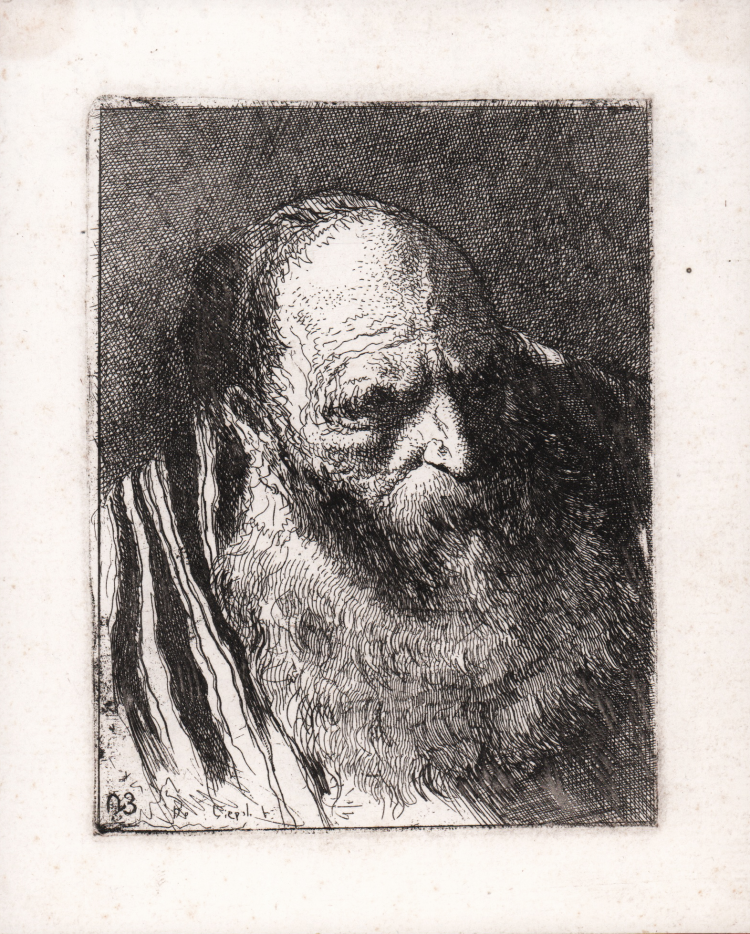



| Reference: | S44159 |
| Author | Giandomenico TIEPOLO |
| Year: | 1757 ca. |
| Measures: | 100 x 130 mm |


| Reference: | S44159 |
| Author | Giandomenico TIEPOLO |
| Year: | 1757 ca. |
| Measures: | 100 x 130 mm |
Etching and engraving, 1757 – 1758 circa, signed Do. Tiepolo F. Example of the second state, with the number 23 in the lower left.
From the the Series of Heads (Raccolta di Teste).
According to Succi, the print, which is included in the Acquisition Mariette and thus datable to 1757-1758, bears affinities with a drawing by Giambattista, preserved at the Musée Atger in Montpellier, also used for another etching in the Raccolta di Teste.
The complete edition of sixty prints (in addition to the dedication and the two titles) of the Raccolta di Teste was published in the first three editions of Giandomenico's Catalogue. The complete series was not published until 1774, when it appeared in the first edition of the Catalogue, as evidenced by the fact that there are no known examples of complete albums published separately from the sheets included in the Catalogue.
The Raccolta, which according to the original plan was to be limited to forty prints, a dozen of which featured women's heads, was begun in the 1750s (by 1758 twenty-six had been engraved and were present in the Acquisition Mariette) and was completed after Giandomenico's return from Spain, between 1771 and 1773.
A fine impression, printed on contemporary laid paper, with margins, very good condition.
Bibliografia
Dario Succi, La Serenissima nello specchio di rame. Splendore di una civiltà figurativa del Settecento. L’opera completa dei Grandi Maestri veneti, II, p. 599, n. 143.
Giandomenico TIEPOLO (Venezia 1727 - 1804)
|
Giambattista’s eldest surviving son, he entered his father’s studio in the early 1740s, where he learnt his art by copying his father’s drawings and etchings. In 1747, aged 20, Giandomenico painted a cycle of 14 paintings, the Via Crucis (Stations of the Cross) for the oratory of the Crucifix in S Polo, Venice (in situ). He avoided any hint of Giambattista’s grandiloquence and created tender scenes that portray the suffering of Christ, the grief of his followers and the cold objectivity of the bystanders in a straightforward manner. From 1750 to 1770 Giandomenico was both his father’s assistant and associate as well as an independent artist, although at times the roles merged. From 1750 to 1753 they were preparing and executing the fresco decorations in the Würzburg Residenz, but Giandomenico was also producing a large number of his own works, such as the Institution of the Eucharist (1753; Copenhagen, Stat. Mus. Kst). This is painted in the simple and direct manner that is typical of his art both as regards subject-matter—for example the Minuet (c. 1755; Barcelona, Mus. A. Catalunya), where the pleasure of a country dance is conveyed—and composition—for example the Four Camaldolese Saints (c. 1756; Verona, Castelvecchio), in which the figures are very simply grouped together.
|
Giandomenico TIEPOLO (Venezia 1727 - 1804)
|
Giambattista’s eldest surviving son, he entered his father’s studio in the early 1740s, where he learnt his art by copying his father’s drawings and etchings. In 1747, aged 20, Giandomenico painted a cycle of 14 paintings, the Via Crucis (Stations of the Cross) for the oratory of the Crucifix in S Polo, Venice (in situ). He avoided any hint of Giambattista’s grandiloquence and created tender scenes that portray the suffering of Christ, the grief of his followers and the cold objectivity of the bystanders in a straightforward manner. From 1750 to 1770 Giandomenico was both his father’s assistant and associate as well as an independent artist, although at times the roles merged. From 1750 to 1753 they were preparing and executing the fresco decorations in the Würzburg Residenz, but Giandomenico was also producing a large number of his own works, such as the Institution of the Eucharist (1753; Copenhagen, Stat. Mus. Kst). This is painted in the simple and direct manner that is typical of his art both as regards subject-matter—for example the Minuet (c. 1755; Barcelona, Mus. A. Catalunya), where the pleasure of a country dance is conveyed—and composition—for example the Four Camaldolese Saints (c. 1756; Verona, Castelvecchio), in which the figures are very simply grouped together.
|